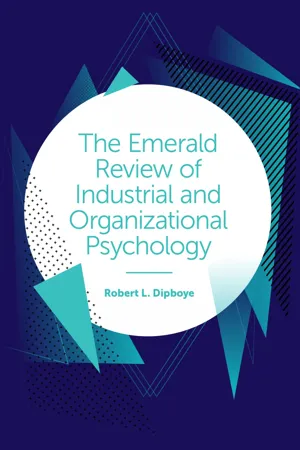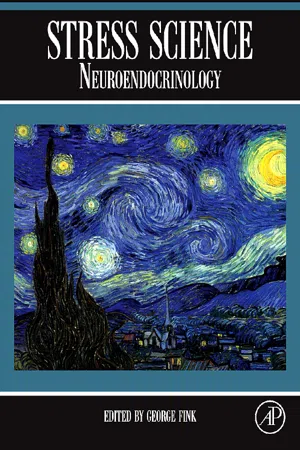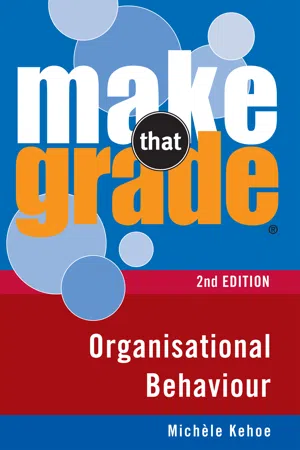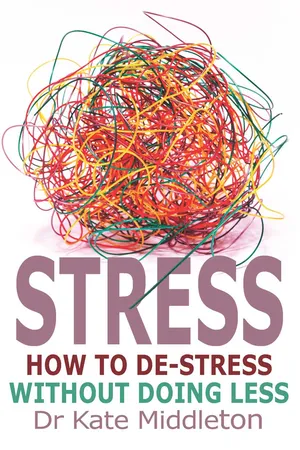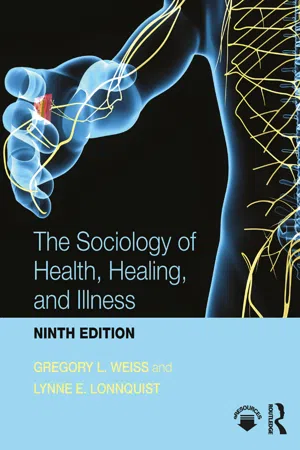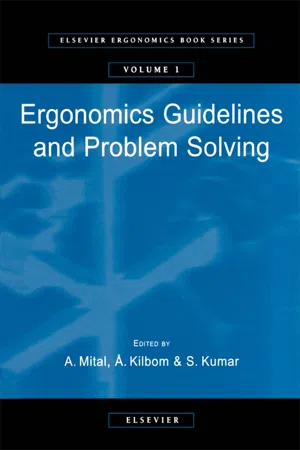Psychology
Stress
Stress refers to the body's response to a demand or challenge, often resulting in feelings of pressure, tension, and anxiety. It can be triggered by various factors, such as environmental changes, work demands, or personal relationships. Chronic stress can have negative effects on both physical and mental health, leading to conditions like anxiety disorders and depression.
Written by Perlego with AI-assistance
Related key terms
Related key terms
1 of 4
Related key terms
1 of 3
12 Key excerpts on "Stress"
- Robert L. Dipboye(Author)
- 2018(Publication Date)
- Emerald Publishing Limited(Publisher)
So, what is Stress? Before providing a working definition, I need to correct several popular misconceptions (Selye, 1974). Stress is not something that can or should be eliminated entirely. Many of the most Stressful events in your life are the challenges and excitement making life worthwhile. Stress is not simply something occurring in your head to be ignored. Stress has real consequences for mental and physical well-being. Stress is not simply a matter of anxiety or nervous tension you can eliminate by calming your emotions. Stress also consists of physiological reactions that are often unconscious and not controllable. Finally, Stress occurs not only as a result of overstimulation and overexcitement but also from boredom and understimulation. Jobs experienced as monotonous and requiring long periods of inaction are often just as Stressful as dangerous or exhilarating jobs.Stress is the total experience to special physical and/or psychological demands on a person that exceed the resources of the person to deal with the circumstances. Consequently, there are unusual psychological, physiological, and/or behavioral responses and long-term negative consequences for health, performance, and well-being (Blies, Edwards, & Sonnentag, 2017; Ivancevich & Matteson, 1980; Mason, 1975; Monat & Lazarus, 1985; Väänänen, Murray, & Kuokkanen, 2014). This definition identifies three essential elements of Stress.Stressors
The circumstances in the outside world which are antecedents to Stress and impose demands on the individual are called Stressors. If asked to identify what causes Stress in one’s life, the list is likely to include events such as a final exam, an overdrawn bank account, an accident, the theft of a car, major surgery, chemical fumes, a bad marriage, an abusive supervisor, or work overload. The Stress associated with negative events is called diStress. Stressors come in the form of threats, hindrances, and challenges (Tuckey, Searle, Boyd, Winefield, & Winefield, 2015). Direct threats inflict harm or loss, such as a coworker who threatens violence against an employee. Hindrances consist of obstacles to growth and accomplishment, such as unclear role requirements. Challenges are task demands that pose difficulties, such as the need to work fast or on many tasks simultaneously, but also offer opportunities for accomplishment.- eBook - ePub
Stress Science
Neuroendocrinology
- George Fink(Author)
- 2010(Publication Date)
- Academic Press(Publisher)
There has been much controversy and debate about Selye’s concepts and particularly Selye’s view that Stress is best regarded as a nonspecific response. Because of their heuristic value, these points will be further considered later.Other definitions, reviewed in detail by Selye in his treatise Stress in Health and Disease , include the following:1. In behavioral sciences, Stress is regarded as the “perception of threat, with resulting anxiety discomfort, emotional tension, and difficulty in adjustment.”2. In the group situation, lack of structure or loss of anchor “makes it difficult or impossible for the group to cope with the requirements of the situation, and the problem of leadership and interpersonal behavior becomes one of evolving or supplying a structure or anchor and of supplying the expertness for coping with the demands of the situation.”3. Stress can also be defined in terms of pure neuro-endocrinology. Eugene Yates, for example, defined Stress as any stimulus that will provoke the release of ACTH and adrenal glucocorticoids. Presumably, the same might apply to the equally powerful sympathetic markers of Stress, underscored earlier by Walter Cannon.4. Finally, Selye also mentions Richard Lazarus, famous for his work in cognitive psychology and focus on the emotions. Lazarus underscores the difficulties of reaching a precise overarching definition of Stress by setting out the following different meanings of the term: “In spite of consistent confusion about the precise meaning of the term, Stress is widely recognized as a central problem in human life. Scientists of many disciplines have conceptualized Stress but each field appears to have something different in mind concerning its meaning. For the sociologist, it is social disequilibrium, that is, disturbances in the social structure within which people live. Engineers conceive of Stress as some external force which produces strain in the materials exposed to it. Physiologists deal with the physical Stressors that include a wide range of stimulus conditions that are noxious to the body. In the history of psychological Stress research, there has been no clear separation between physical Stressors which attack biological tissue systems and psychological Stressors which produce their effects purely because of their psychological significance.” - eBook - ePub
Stress Management
From Basic Science to Better Practice
- Wolfgang Linden(Author)
- 2004(Publication Date)
- SAGE Publications, Inc(Publisher)
Stressor to refer to a causative agent, a trigger for this process.A two-step sequence of “Stress” is also reflected in definitions found in psychological textbooks. Girdano, Everly, and Dusek (1993, p. 7) state, “Stress is the body reacting. It is psychophysiological (mind-body) arousal that can fatigue body systems to the point of malfunction and disease.” Hence, popular and scientific definitions see “Stress” as a process in which external and internal stimuli, forces, or systems interact, where triggers activate a response system that may lead to exhaustion and vulnerability (Wheaton, 1996).My definition of Stress, as applied to Stress management, is this:Stress is a mediational process in which Stressors (or demands) trigger an attempt at adaptation or resolution that results in individual diStress if the organism is unsuccessful in satisfying the demand. Stress responding occurs at physiological, behavioral, and cognitive levels. Stress is more than just acute subjective or physiological activation and has its potentially most deleterious health effects when it becomes chronic.Before delving further into the history and basic research on the Stress concept, it should be clarified that, consistent with my definition of Stress, the emphasis is going to be on chronic Stress and its health consequences rather than on a singular, traumatic kind of Stress exposure. Exposure to a traumatic event, like witnessing or being subjected to violence, is a profound event with potentially grave and long-lasting psychological sequelae; in their most severe form, these sequelae qualify for posttraumatic Stress disorder, which can be quite debilitating. Little is known about the long-term physical health consequences of traumatic Stress (with the exception of early life exposure to trauma, discussed below) and the treatment techniques embraced by Stress management (Ong, Linden, & Young, 2004) are not treatments of choice for posttraumatic Stress disorder (Taylor, Lerner, Sherman, Sage, & McDowell, 2003). - eBook - ePub
- Michele Kehoe(Author)
- 2013(Publication Date)
- Gill Books(Publisher)
6 Stress IN THE WORKPLACE Objectives This chapter will help you to: Define Stress. Describe the General Adaptation Syndrome. Identify the difference between euStress and diStress. Characterise Type A and B personality profiles. Examine the causes of life and organisational Stressors. Understand the consequences of Stress to the individual and the organisation. Recommend individual and organisational coping strategies. 6.1 Stress defined Stress is complex and the experience of it is very individual due to its many causes and consequences. Stress is a reality of life in general and therefore part of the experience of work. The most important aspect of Stress is managing it effectively. The benefits for organisations in creating a work environment that helps employees manage the demands of life within and without the workplace include healthier employees, reduced absenteeism, increased productivity and an enhanced reputation. According to Moorhead and Griffin (2012), Stress can be defined as ‘ a person’s adaptive response to a stimulus that places excessive psychological or physical demands on that person ’. The source of Stress must be perceived by the person to be excessive. Wagner and Hollenbeck (2010) assert that Stress is ‘ an unpleasant emotional state ’. Arroba and James (1991) state that Stress is ‘ a person’s response to an inappropriate level of pressure. It is a response to pressure, not the pressure itself. ’ This description of Stress highlights the fact that Stress is caused by pressure from many different sources, such as peer pressure, financial pressure or exam pressure. It is when an individual believes that the pressure they are under is too much for them to handle that Stress is experienced. When placed under a lot of pressure, some people experience no Stress and others only need a small amount of pressure to suffer the side effects of Stress - eBook - ePub
Stress
How to de-stress without doing less
- Kate Middleton(Author)
- 2011(Publication Date)
- Lion Books(Publisher)
Stress is linked to the development of almost all mental health problems and, as we will see, can trigger both physical and psychological ill health. But in the same way that we like to believe we are not at risk of mental health problems, we also often think we are immune from the impact of Stress. Particularly in a culture where life is jam-packed, full of pressure and the need to achieve, we feel that we should manage to be superhuman and cope with all the things thrown at us. We’ll freely admit that life is ‘Stressful’ but put ourselves under pressure never to show any signs of that Stress. We slip into believing that by ignoring Stress we can avoid it having any impact on us.So, what is the truth about Stress?If you listen to a doctor or psychologist talking about Stress, you’ll quickly realize that they mean something much more than a response that is all in our minds. In fact, Stress is a very real physical phenomenon that causes real physiological changes within our bodies and our brains. Stress is something that we all need to be aware of, because many of the signs and symptoms Stress can trigger are actually caused by the physiological changes that it has triggered.This doesn’t mean that the way we respond – emotionally and psychologically – to situations, or indeed to Stress, doesn’t have an impact. Our individual response to difficult things, as well as some basic things about the way our minds work, can certainly make Stress more or less of a problem, and we’ll talk about some of these things in later chapters. But at the root of Stress are real physical changes with real physical impacts.What we call Stress refers to a response that our brain triggers when the situation we find ourselves in requires us to do something specific or be ready to react in a certain way. It might be that something is happening now, or that our brain has detected a chance that something might happen and so primes our body to be alert in case it does. The actual response could be any number of things. It may be about getting us physically ready, such as the well-known ‘fight or flight’ response that occurs if we feel threatened or at risk. Or Stress can be part of our brain keeping us mentally prepared – for example, concentrating on something for a long time and focusing our attention. Stress can be something that happens in a flash and is over very quickly (‘acute’ Stress), or something that lasts longer and requires a more long-term physiological adaption (chronic Stress). - eBook - ePub
- Gregory L. Weiss(Author)
- 2017(Publication Date)
- Routledge(Publisher)
Stress as “a state of imbalance within a person, elicited by an actual or perceived disparity between environmental demands and the person’s capacity to cope with these demands.” Stress occurs in response to “strainful and threatening circumstances in the environment” and has clearer boundaries than states such as anxiety or depression, which are more global, more diffuse, and may exist “even in the absence of specific threats” (Pearlin and Schooler, 1978:4).HISTORICAL DEVELOPMENT OF THE Stress CONCEPT
The idea of Stress has existed for centuries. As discussed in Chapter 2 , such historical luminaries as Hippocrates believed in the humoral theory of illness—that positive health results from a mind and body in harmony—and this is perhaps the earliest characterization of an individual who is not “Stressed out.” Hippocrates’ belief in the self-healing powers of the body is also consistent with an understanding of the body’s adaptation to Stress.Historical records indicate that in the fourteenth century the term was equated with hardship and affliction, and in nineteenth-century medicine, Stress was cited as a cause of ill health, as many diseases were attributed by physicians to conditions of “melancholia,” “grief,” or “despair.” Clearly, by the 1800s, there was widespread recognition of the link between mind and body.Ironically, Pasteur’s demonstration that bacteria cause disease (the germ theory of disease) led many physicians and medical researchers to confine their attention to such germ-caused diseases in the hope of finding specific disease etiology and appropriate “magic bullets.” In doing so, many of them abandoned interest in the less concrete areas of attitudes and emotions.Walter Cannon and Hans Selye
Early in the twentieth century, Walter Cannon, an American physiologist, used the term homeostasis - eBook - ePub
Teacher Well-Being
Looking After Yourself and Your Career in the Classroom
- Elizabeth Holmes(Author)
- 2005(Publication Date)
- Routledge(Publisher)
CHAPTER 2 Stress, the good and the badStress: a state of mental or emotional strain or tension resulting from adverse or very demanding circumstances(The New Oxford Dictionary of English)It’s a phrase we hear all the time, in books, in newspapers, on television; even young children talk in terms of ‘being Stressed’. Research papers report the damage being done to our ‘social environment’ by insufficient notice being taken of the Stress that employees feel, and the devastating impact this can have on the well-being of individuals is apparently stifling creativity and motivation.Stress in the workplace is now at record levels, with the number of days lost as a result of work-related Stress, anxiety and depression having doubled since 1995. In fact, it is thought to be the primary reason for taking time off work—above, even, common reasons such as backache and colds. Stress also evidently affects our home life, too, with debt and divorce in particular at record levels.Definitions and perceptions of Stress
Perhaps it would be fair to say that Stress gets a bad press! But what, exactly, does it mean? Used to describe everything from life-threatening events to situations that merely disrupt our sense of comfort, and a whole array in between, ‘Stress’ has meaning for most, if not all, adults and some children. That said, it’s difficult to reach a universally accepted definition. Perhaps it is the fact that we all apply our own meaning to the term that has helped it to become the epidemic of modern life.Regardless of definitions and perceptions, what is widely accepted is that the states of insufficient Stress and excessive Stress are both to be avoided if our sense of well-being is to be supported. One useful analogy that is often used compares Stress with electricity. A certain amount is needed in order for things to work, but too much and you’ll blow them up.EXAMPLE A PERSONAL VIEW OF StressStress to me is when I’m scared to write a ‘to do’ list. It’s when my skin breaks out and my hair feels dry. It’s invariably when just about everything goes wrong—car, washing machine, you name it! It’s when I wake up in the night thinking about lesson plans, marking, meetings, conversations I’ve had and conversations I should have had. It’s feeling distracted when I’m not working and exhausted when I am. That’s what Stress is to me. - eBook - ePub
- Konstantinos Perrotis, Cary L. Cooper(Authors)
- 2017(Publication Date)
- Routledge(Publisher)
In the beginning it was used mostly in the field of psychosomatic medicine and physics, but it was in 1946 that Hans Selye first mentioned that the ways through which Stress affects and is perceived by an individual are unclear and that further examination is needed to fully understand such a popular concept. While at that time period there was no unique definition of Stress, the terms ‘Stressor’ and ‘strain’ were widely used. ‘Stressor’ referredto the environmental stimulus that could exert pressure on an individual (i.e. working long hours), and ‘strain’ referred to the individual response that could be expressed either physically, psychologically or behaviourally.During the exploration of the Stress concept, researchers were mainly focused on three particular approaches:- Stress as the dependent variable (the response): Stress is viewed as a response to a stimulus that arises from an upsetting situation or the environment, e.g. work overload or harmful environmental settings. Responses may be physiological or behavioural.
- Stress as the independent variable (the stimulus): Stress is viewed as an external phenomenon that acts upon the individual, but without taking into consideration the importance of an individual’s perceptions and past experiences. Stress is considered as a disturbing environmental factor.
- Stress as the intervening variable (the interactionist approach): Stress is viewed as the interaction between individuals’ perceptions and their responses towards an external stimulus. In other words, Stress refers to the lack of fit that exists between the individual and the environment, and it is the combination of both the stimulus and the response approach (Fisher, 1986).
1. Stress as the dependent variable: response-based definitionsStress can be tracked historically back to the 18th century, where it was used mostly in the field of science and engineering as a concept to describe the force or pressure that was placed upon a material object or person. In such cases, strain was reflected as the resulting distortion on the object/subject under study (Kahn & Byosiere, 1992).In 1935 the Stress definition was transferred into psychosomatic medicine and biology by Sir Walter Cannon under the ‘fight or flight’ theory. Cannon’s main interest was to investigate the physiological reaction of individuals and animals when they encountered a perceived threat, such as extreme cold or lack of oxygen. Such reactions dictate either a ‘fight or flight’ mode where the organism either stays and confronts the threat or, if the threat is perceived as overwhelming, flees. The easiest way to picture that is to imagine the reactions of a cat when under the perception of threat. When a cat feels threatened it takes a stiff, straight-legged upright stance. At this precise point it decides whether to fight or take flight, with its back legs heading forward (to fight) and its front legs heading backwards (to flight). A pure physiological response to Stress! When it comes to humans, this is the most common reaction to a Stressful threat. - eBook - ePub
Tales of Agonies
A Psycho-Spiritual Prism
- Emmanuel Abur(Author)
- 2023(Publication Date)
- Austin Macauley Publishers(Publisher)
Of course, normal Stress is inevitable in life. In most cases, it is part of our daily routine. Thus, daily traffic jams in busy cities like Lagos and Rome, running to catch up with the bus or train every morning, struggling hard to meet up with assignment deadlines, studying hard to pass a difficult statistics or chemistry exam, eight hours of daily work from Monday to Friday, observing long queues in the bank, hospital, filling station, etc., are everyday Stressful experiences we often go through unscathed. Rather than destroy us, they strengthen us and boost our adaptive abilities.On the contrary, nasty experiences of continuous marital conflict, separation or divorce, daily clash with a notorious child who is a drug addict and/or a drunkard, being a victim of repeated sexual assault or physical abuse, a perpetual conflict with the boss at work, experiencing war, violence, kidnapping, or general insecurity, etc., are examples of acute or chronic Stress which can break us down.Such is the diStressing experience that many people in Nigeria, especially Christians, and in many other parts of the globe are going through, as we saw in the previous chapter. In this chapter, we cursorily present the incidence of Stress vis-a-vis the experience of Christians in Nigeria today, and of course, other parts of the world.Understanding Stress
In biomedical sciences, Stress is mainly understood as an organism’s response to adverse stimulation. In psychology, it is usually understood as the process where a person and the environment interact, the psychological perception of the danger or pressure associated with that experience, and the bodily response consequent upon the menacing perception.1 From these two conceptions emerge three broad perspectives of Stress, namely the response-based perspective, the stimulus-based perspective, and the cognitive-based perspective.The Response-Based Perspective
Hans Selye, the Hungarian Canadian endocrinologist, who carried out important scientific work on the ‘non-specific response of the body to any demand’,2 distinguished between a Stressor (the stimulus) and Stress (which is the response). A Stressor, according to him, “is anything that causes the release of Stress hormones.”3The response to the stimulus (the Stress), he points out, follows a typical three-stage pattern in humans and animals, called the general adaptation syndrome (GAS). In this pattern, the body initially defends itself against adverse circumstances by activating the sympathetic nervous system, known as the alarm reaction. It mobilizes the body for the fight or flight response, which can be seen phylogenetically as an adaptive short-term reaction to an emergency. - No longer available |Learn more
- Charles Abraham, Mark Conner, Fiona Jones, Daryl O'Connor(Authors)
- 2016(Publication Date)
- Routledge(Publisher)
- Describe what is meant by Stress. Discuss whether Stress is a growing problem.
- Describe and evaluate key theoretical approaches to Stress.
- Describe and evaluate key ways in which Stress has been measured.
- Discuss and evaluate research evidence concerning the links between Stressors and a) illness; and b) health behaviour.
- Describe the impact of individual differences in responses to Stressors.
What is Stress?
The increase in press and television coverage of Stress over the last few decades has corresponded to a growth in research and public awareness. Indeed, Stress is now the most common cause of long-term sick leave and is frequently shown to be a very important factor accounting for nearly 10 million working days lost per annum in the UK (HSE, 2015 ). In 2014/2015, Stress accounted for 35 per cent of all cases of work-related illnesses in the UK (i.e. 440,000 cases). In the United States, the impact of Stress is also far reaching, with 66 per cent of Americans reporting that Stress is impacting on their physical health and 63 per cent believing the same for their mental health (American Psychological Association, 2012 ).We can all empathize with feeling Stressed. However, it is not always clear what we mean by ‘Stress’ (Segerstrom and O’Connor, 2012 ). Over centuries, ‘Stress’ has come to mean pressure or strain (e.g. Cooper and Dewe, 2004 ). Scientific interest dates back to the early part of the twentieth century. For example, World War I concerns about industrial efficiency led to studies of fatigue in wartime munitions factories and the war focused attention on ‘shellshock’, which was subsequently acknowledged as a manifestation of post-traumatic Stress disorder (Lazarus, 1999 ).There have been three different approaches to the study of Stress: the stimulus-based or engineering approach; the response-based or medico-physiological approach; and the psychological ‘interactional-appraisal’ approach (Cox, 1978 - eBook - ePub
Stress at Work
A Sociological Perspective
- Chris Peterson(Author)
- 2018(Publication Date)
- Routledge(Publisher)
CHAPTER 1 Stress as a Psychophysiological ProcessIn this chapter I trace developments in the concept of Stress, as a physiological reaction and as a psychophysiological process. This historical review covers presociological inquiries of Stress. It examines many of the debates on the meaning of Stress, based on early differences in the meaning of the Stress response. While these approaches have a number of limitations, an examination shows how early differences in biophysiological and later psychological research contributed an important understanding to the Stress response.While earlier, purely physiological approaches provide information about bodily reactions to Stress, they do not provide a sufficient understanding of a broad range of processes involved in the Stress response. Parallel and more recent psychological research provides some important insights into why different people experience differing amounts of Stress from the same Stressors. These findings make important contributions to our understanding of the psychophysiological nature of Stress.However, psychophysiological approaches fail to account for a broader range of sociocultural factors, a topic addressed in Chapter 2 . Yet these psychophysiological processes do provide an important basis for our understanding of Stress, albeit at the individual level of personal experience.While the early biophysiological and psychological researchers have made important contributions, our knowledge about the Stress response has recently changed in some important ways. Technological developments in testing procedures and equipment have also produced major changes in our understanding of this response. Yet certain limitations to a thorough understanding of biophysiological and psychological processes remain. We need to employ a critical framework when dealing with various assumptions about the biophysiological aspects of the Stress response that require questioning.The chapter covers three issues. The first is a review of the pioneering work of Hans Selye and a critical evaluation of early developments in the Stress concept. I then review the influence of psychologically oriented research into the effects of emotional response on physiological reactions and evaluate it for its influence on the Stress concept. Finally, I discuss the physiology of the Stress response, based on the above approaches. - eBook - ePub
- A. Mital, Å. Kilbom, S. Kumar(Authors)
- 2000(Publication Date)
- Elsevier Science(Publisher)
1982 ) demonstrated that the natural response of any organism to a demanding or threatening situation or experience (Stressor) was a predictable series of nonspecific changes in physiological, psychological and behavioural functions which he named the General Adaptation Syndrome. This syndrome was shown to be a temporally-arranged sequence of changes called the alarm, resistance and exhaustion stages respectively, which Selye demonstrated could result ultimately in illness.The initial response to perceived Stressors involves all body systems. Overall this initial response acts to heighten the level of arousal and mobilise the person’s resources for physical action. This occurs by increasing heart rate, blood pressure, muscle tension and general physical and mental alertness. Mital and Mital (1984) , for example, showed that exposure to a Stressor for a short period, such as an examination, produced significant changes in blood pressure, pulse rate and oral body temperature.If the Stressor persists, the resistance stage follows in which the person attempts to manage or cope with the demand or threat through psychological, physiological and behavioural means. At this stage, the initial physiological changes such as increased hormone levels and increased heart rate return to normal. If the attempts to control or cope with the Stressor are unsuccessful, the exhaustion stage is reached in which psychological and physiological capacities become overstretched and the individual becomes susceptible to illness and disease. An increasing number of diseases have been identified as having Stress-related origins (Quick et al., 1987 ).If the Stress response is not managed in the initial stages, a number of adverse outcomes are likely to occur. The behavioural consequences that have been identified include increased smoking (Lindenthal et al., 1972 ; Conway et al., 1981 ) alcohol and drug abuse (Jones and Boye, 1992 ) and poor work performance (Hockey, 1983 ). The adverse psychological consequences that have been identified include increased anxiety, depression, irritability and aggression and sleep disturbances (Quick and Quick, 1984
Index pages curate the most relevant extracts from our library of academic textbooks. They’ve been created using an in-house natural language model (NLM), each adding context and meaning to key research topics.
Explore more topic indexes
Explore more topic indexes
1 of 6
Explore more topic indexes
1 of 4
